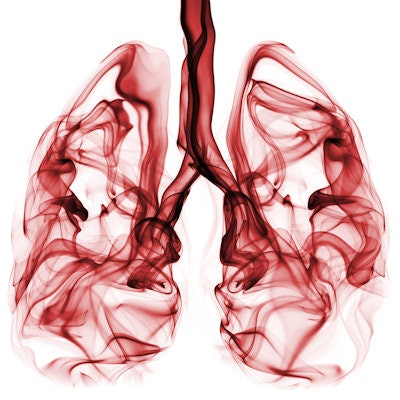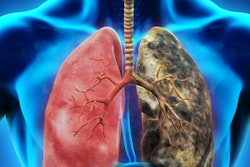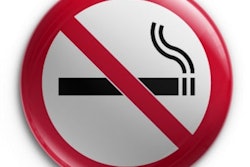
Is the risk model used in the National Lung Screening Trial (NLST) really the best one for determining which individuals should get CT screening for lung cancer? Maybe not, according to Canadian researchers who published what they think might be a more effective model in an October 17 paper in Lancet Oncology.
The researchers tested whether the Pan-Canadian Early Detection of Lung Cancer (PanCan) risk prediction model was better than NLST criteria in more than 2,500 current and former smokers from eight cities across Canada. They found that using PanCan to decide who should get screened made CT lung screening more effective -- especially for finding early-stage disease (Lancet Oncol, October 17, 2017).
The results indicate that risk models like PanCan could be more effective than NLST criteria for selecting patients for CT lung cancer screening, according to an accompanying commentary by Dr. Harry de Koning, PhD, of Erasmus University Medical Center in Rotterdam, the Netherlands.
"[This study] substantiates the ad-hoc analyses based on NLST that show superiority of using risk prediction models over the more classic risk factors -- namely, age and smoking history alone," de Koning wrote.
PanCan risk prediction model
The highly regarded NLST demonstrated that low-dose CT screening of high-risk smokers can help reduce lung cancer deaths by more than 20%. This finding helped motivate the U.S. Preventive Services Task Force (USPSTF) to issue a draft recommendation offering annual CT screening to individuals who met the NLST criteria -- namely, individuals ages 55 to 80 years who had smoked at least 30 pack-years and who had smoked regularly during the past 15 years.
But are the NLST/USPSTF criteria really the best model to follow?
The "USPSTF entry criteria do not quantify risk, and a sizeable proportion of Americans diagnosed with lung cancer fail to meet the USPSTF screening entry criteria," wrote the study team led by Martin Tammemagi, PhD, of Brock University in St. Catharines, Ontario, Canada.
Seeking to provide more-encompassing criteria for lung cancer, the researchers developed the first version of the PanCan method of lung cancer detection based on a predictive risk model. They have updated the PanCan model since its formation in 2007, with the most recent version being the PLCOm2012 model, based on data from the Prostate, Lung, Colorectal, and Ovarian (PLCO) screening trial for predicting lung cancer risk.
From September 24, 2008, to December 17, 2010, the researchers conducted a prospective study in Canada using the PanCan risk prediction model to select more than 2,500 current and former smokers between the ages of 50 and 75 years who had at least a 2% risk of developing lung cancer within six years based on the model. The various factors that determined risk included age, education level, family history of lung cancer, body mass index (BMI), number of chest x-rays taken, and history of smoking and chronic obstructive pulmonary disease.
Low-dose thoracic CT scans were performed on the participants, and a subspecialty-trained chest radiologist reviewed the scans. After the initial screening exam, patients were followed for five and a half years. Participants with at least one noncalcified lung nodule on their CT scan returned for a follow-up scan at three- to 12-month intervals, based on nodule size, for at least two years.
Increased efficiency
Throughout the course of the study, the researchers identified 172 lung cancers in 164 individuals. The cumulative incidence of lung cancer in the PanCan study turned out to be higher than the incidence reported in the NLST.
| PanCan vs. NLST for CT lung cancer screening efficiency | |||||
| NLST | PanCan | ||||
| Incidence of lung cancer | 4% | 6.5% | |||
| Detection rate of early-stage lung cancers (I or II) | 57% | 77% | |||
| Cost of screening per life-year gained | ~$81,000 | ~$16,000 | |||
Compared with the NLST criteria, the PanCan model spotted a higher percentage of lung cancers, detected more in the early rather than later stages of lung cancer, and resulted in a lower cost of screening per life-year gained.
The PanCan model also demonstrated good overall predictive capabilities; it achieved a relatively low Brier score of 0.0061, where 0 indicates perfect prediction. When tested in the PLCO trial, the PanCan model churned out an area under the curve of 0.783.
Furthermore, a subsequent retrospective validation study showed that the newest version of the PanCan model produced better discrimination, calibration, and clinical usefulness than nine other risk prediction models, according to the researchers.
A key secondary finding from the new study was that participants without lung nodules at least 1 mm in diameter had a significantly lower risk of developing lung cancer. This outcome falls in line with the finding that participants without nodules 4 mm or larger had a considerably smaller risk of lung cancer in both the NLST and the Dutch-Belgian Randomized Lung Cancer Screening Trial (NELSON).
"Collectively, results from these studies suggest that individuals without lung nodules or who have very small lung nodules in their baseline low-dose CT could have biennial instead of annual screening to reduce healthcare costs and radiation exposure," the authors wrote.
Catching lung cancer early
Using the PanCan predictive risk model to identify individuals at risk for lung cancer appears to be more effective than using other criteria, despite the limitations of the study, which included the fact that it was not randomized or controlled, according to the researchers. In addition, the study did not directly compare its criteria with those used in the NLST.
Though the PanCan model may help substantiate the value of CT for lung cancer screening, critical questions remain, such as who physicians should screen and how they can make screening as safe as possible, de Koning wrote in the accompanying commentary.
"In the PanCan study, more than 50% of willing individuals were found by the investigators not to be at high enough risk for screening," he wrote.
To answer those and similar questions, the researchers have already launched a pilot study applying the PanCan model at three sites in Ontario. The group also decided to expand the PanCan study this year to investigate the effects of genetics and air pollution on the risk of developing lung cancer.
The goal is to use the screening model to catch potential cases of lung cancer while it is still treatable, according to Dr. Stephen Lam of the University of British Columbia, who participated in the study.
"We have the means to identify high-risk people, and we know we can find cancer early," Lam said.




















